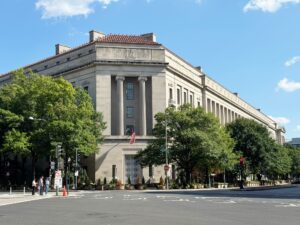By Scott Merrill

In an extraordinary move, the US Department of Justice (DOJ), under President Donald Trump, sued all 15 District of Maryland judges this summer over a procedural order in immigration cases. Though quickly dismissed, the lawsuit is already seen as a major episode in the history of judicial independence and separation of powers.
On May 28, Chief Judge George L. Russell, III issued a standing order directing the clerk’s office to automatically pause deportations for two business days whenever a habeas petition was filed. The pause gave judges time to review urgent claims from immigrants facing imminent removal.
To advocates, the standing order was a modest safeguard. To the DOJ, it was an affront. Less than a month later, the department filed suit against the Maryland court, its clerk, and every judge. The complaint argued the order functioned as a blanket injunction against executive immigration authority and violated Supreme Court precedent.
On August 26, US District Judge Thomas T. Cullen of Virginia dismissed the complaint in sharp terms, ruling that judges are immune from liability for judicial acts.
“Whatever the merits of its grievance … the Executive must find a proper way to raise those concerns,” he wrote, adding that the correct path was appellate review, not litigation against judges.
Why the Case Matters
Daniel Pi, a professor at the University of New Hampshire Franklin Pierce School of Law (UNH Law), says the lawsuit struck at “principles absolutely fundamental to the Constitution.”
“The proper process to dispute an erroneous judicial decision is to appeal it,” Pi says. “It has never been an acceptable remedy to sue the judge, much less all the judges. To do so violates the separation of powers, judicial immunity, and standing rules.”
For Pi, the danger is larger than the lawsuit.
“Trump could simply say, ‘I don’t care what the courts say, I’m going to do what I want.’ The courts have no army, no power of the purse, no real enforcement power. That’s the nightmare for Chief Justice [John] Roberts and the judiciary as an institution.”
Historical Fault Lines and Fragile Norms
The Maryland case recalls earlier showdowns over executive power. In 1952, the Supreme Court blocked President Harry S. Truman’s attempt to seize steel mills during the Korean War in Youngstown v. Sawyer. Truman ultimately gave in to the Supreme Court’s ruling and returned control of the mills to their owners.
The Court’s authority, Pi says, has always rested on compliance by the other branches. He traces some of today’s tensions back to Marbury v. Madison (1803), the foundational case that established judicial review. He described the decision in that case as a trick in which the Court claimed the authority to strike down laws while avoiding a direct confrontation with President Thomas Jefferson.
“[The Supreme Court] essentially claimed the power to interpret the Constitution while appearing to do nothing,” Pi says. “They knew Jefferson would not listen if they told him what he was doing was unconstitutional. So instead, they said the law that gave them that power was itself unconstitutional. In other words, they said: ‘We have the power to say Congress didn’t have the power to give us the power to tell you what to do. Therefore, we have the power to interpret the Constitution.’ And Jefferson couldn’t object, because he got what he wanted.”
The Court then largely avoided striking down laws for the next half-century, Pi notes.
“By the time they actually used judicial review again, everyone had just sort of forgotten it was ever controversial,” he says. “The Court’s authority has rested ever since on this really fragile norm, a presumption that the other branches and the states will abide.”
Pi points to President Andrew Jackson and the Cherokee removal as an example of outright defiance by a sitting president. After the Supreme Court ruled that Georgia’s actions against the Cherokee were unconstitutional, Jackson, championing the Indian Removal Act of 1830, allegedly responded: “John Marshall has made his decision; now let him enforce it.” The result was the Trail of Tears, in which thousands of Native Americans were forcibly relocated west of the Mississippi.
“That’s the worst-case scenario,” Pi says. “When the president just says: ‘We’re going to do what we want.’ The courts have no mechanism to stop it.”
Trump and the Edge of Crisis
Pi argues the Trump administration has repeatedly tested the limits of executive authority.
“They come close, then retreat, which at least shows some recognition of obligation,” he says. But Vice President JD Vance has been more blunt, warning the administration may not comply if too many rulings go against it.
“That would be a constitutional crisis,” Pi says. “Historically, the Constitution means what the Court says it means. If the president asserts his own interpretation as binding, we don’t know what the Constitution means anymore.”
For now, Trump has pulled back short of outright defiance of the Court. But, Pi cautions, “the whole constitutional order is based on the assumption that the Executive will ultimately comply.”
He adds: “The Trump administration keeps coming right up to the line. Because they have a friendly Supreme Court, defiance is less attractive for now. But the rhetoric makes it impossible to know if or when they’ll cross it. Judges must be free to decide cases without fear of personal liability or retaliation. That independence is the cornerstone of the constitutional system. But it only works if presidents respect it.”
While the Maryland order remains in effect, the DOJ has signaled an appeal of Cullen’s dismissal. The case could reach the appellate courts, or even the Supreme Court.
